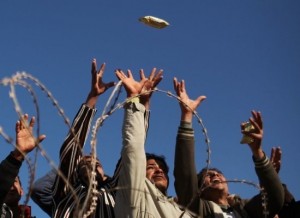I recently read a book with an illustration that profoundly resonated with my life experience. The author (Paul F. Knitter) compares one’s inhe rited worldview (culture, tradition, geography, etc.) to that of a telescope. A telescope offers a beautiful and clear view of a few starts in the sky, but it fails to offer such a view of the whole universe. Because we all look through our telescope with a specific worldview, we must humbly ask to look through another’s telescope in order to get a more full understanding of the way God works in the world.
rited worldview (culture, tradition, geography, etc.) to that of a telescope. A telescope offers a beautiful and clear view of a few starts in the sky, but it fails to offer such a view of the whole universe. Because we all look through our telescope with a specific worldview, we must humbly ask to look through another’s telescope in order to get a more full understanding of the way God works in the world.
Jan and I have traveled to roughly 30 countries in the past few years. Our travel has been less of vacation and more of a pilgrimage. From refugee camps in the West Bank to war torn towns in Croatia to the rainforests of Costa Rica, our worldviews have been expanded and our faith been made real in the midst of such pilgrimage. Having taken note of endless conversations and experiences around the world, we have been able to see the face(s) of the Kingdom of God in myriad contexts. For so long, our worldview could only be articulated through the lens of the West, now we can’t help but see the hand of God in the stories of all the inhabitants of the earth.
I once heard pilgrimage beautifully described as seeking self-knowledge in humility while walking down the path of obedience. For the religious, a pilgrim’s destination is the place where God meets humanity. It is a place where they encounter earlier parts of their story and get a glimpse of the divine on earth. Holy pilgrimage has been a central practice in major religions for much of history. For the Muslim, it is the pilgrimage of obedience to Mecca as a way to encounter Allah. For the Jew, it is to Jerusalem where God met his people in the Temple. For the Christian (more common in the Early Church), it is to Jerusalem where one can walk in the footsteps of Jesus’ life, death and resurrection.
A pilgrimage is less about transforming the world and more about being transformed yourself.
When we first started to travel, I can’t say I approached it as one on pilgrimage. No, it was more about having some fun with my wife and exploring the world. The reality is, when you explore the world you quickly find that the world is not simply made up of interesting destinations, but of dynamic individuals. As I began to be swept into the stories of those we encountered, I was quickly confronted with the reality that the God of the universe was just as much at work in the refugee camps of Palestine and the bustling streets of Barcelona as he was in America.
I don’t know if I would have put this in words, but I subconsciously believed that Western Christianity had a corner on the market of God’s favor. As if I/we had it all figured out and travel was simply about visiting other places and people who hadn’t quite “gotten it.”
While I didn’t begin my journey on pilgrimage, the pilgrimage found me. I began to stumble upon earlier parts of God’s Story (which is also my story) and encounter the reality of his inaugurated Kingdom in the most unlikely of places and individuals.
It is those stories that I will share each Monday for the next few months. I share them as one who has been transformed by the unlikely pilgrimage I stumbled upon, and I invite you to look through the telescope they may offer as we encounter the mystery of God’s diverse and growing Kingdom.
Have you had any similar experiences or revelations as a result of cross-cultural travel?

